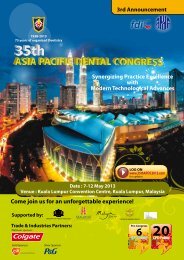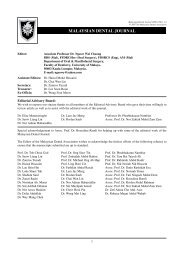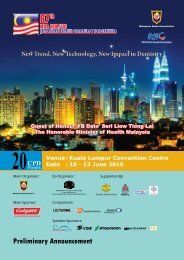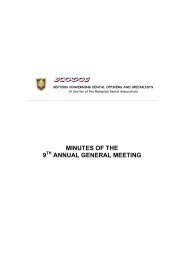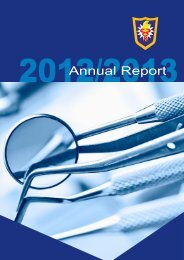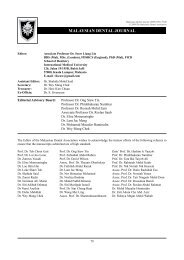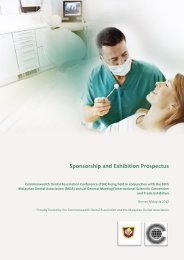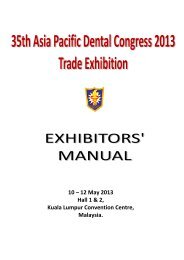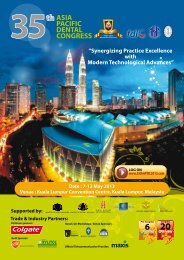Prosthodontic Considerations In The Management Of OligodontiaIn Growing PatientsAuthors:Dr Yew Hsu ZennDepartment of Operative Dentistry, Faculty of Dentistry, Universiti Kebangsaan MalaysiaABSTRACTCongenitally missing teeth creates significant challenges to the clinicians in both diagnosis and management. Theneed for interdisciplinary involvement is essential for optimum dental care. The purpose of this clinical report is todescribe an interdisciplinary management of a 15-year-old adolescent presented with non-syndromic oligodontia.The principle of management is presented with special emphasis on prosthodontic aspects. Various restorativetreatment modalities specified for oligodontia patients are outlined.Key Words: Oligodontia, resin bonded bridge, composite resinsINTRODUCTION<strong>Dental</strong> agenesis is one of the most common dentalanomalies 1 . Conventionally, the term ‘hypodontia’ hasbeen used to describe the condition in which one ormore teeth excluding third molars are congenitallymissing. In a more severe case, ‘oligodontia’, ischaracterized by developmental absence of morethan 6 teeth 2 . <strong>Dental</strong> literature reported significantcontinental variations in the prevalence rates ofhypodontia. In Malaysia, Nik Hussein (1989) 3 foundthat 2.8% of children were affected with a femalepredilection. The general incidence of oligodontia,being a relatively rare condition, is estimated tobe only about 0.1-0.2%. Nevertheless, patientswith oligodontia almost always have accompanyingectodermal abnormalities and syndromes that affectthe maxillofacial growth and ultimately the facialappearance. Therefore, management of patient witholigodontia is often complex and challenging 4 .The general consensus in the literaturesupports the need for interdisciplinary approach inthe management of these patients 5 . The primary aimin the management of hypodontia is to restore bothfunction and esthetic of the patient 6 . Frequently,a joint collaboration of dental disciplines such asprosthodontics, orthodontics, oral surgery andpaediatric dentist is essential to ensure successfultreatment outcome 5,7 . From the standpoint ofprosthodontics, the restorative treatment optionsavailable for management of oligondontia are similar tothe replacement of any missing teeth and the choicesinclude tooth and implant-supported prostheses 8 . Thecomplexity in the prosthetic management of this group ofpatient lies in the presentation of supplemental clinicalfeatures associated with oligodontia. Microdontia 4 ,alveolar ridge atrophy, disruption of occlusal planefrom infraoccluded retained deciduous teeth, reducedvertical dimension and anterior-posterior skeletalrelationship discrepancies 9 are common accompanyingdento-facial features that may complicate restorativetreatment planning and management.In growing individuals, further consideration ofage and timing of intervention is necessary. Jepsonet al (2003) 10 recommended early developmentand planning of the possible long term definitiverestoration. Once a final restorative treatment plan isin place, the necessary adjunctive treatment to achievethe aesthetic and functional space requirements canbe carried out. In a case report of 20 years follow upof a prosthetic rehabilitation of hypodontia, Bergendalet al (2001) 8 adviced the importance of considerationof the changing needs and wishes of the patient duringgrowth while refraining from giving promises on thetreatment outcome.Broadly speaking, prosthodontic managementof oligodontia can be divided into three phases, takinginto account the age and developmental stages ofthe patient. The initial restorative phase is vital notonly to maintain the remaining dentition but also topromote emotional and psychosocial well being of thepatient. During this phase of treatment, it is importantto inculcate good dental attitude through behaviouralmanagement as the dental care of these patients isusually over an extensive period of time. The nextphase is referred to as the interim restorative phase.21<strong>Malaysian</strong> <strong>Dental</strong> Journal Jan-Jun 2011 Vol 32 No 1© 2011 The <strong>Malaysian</strong> <strong>Dental</strong> <strong>Association</strong>
Prosthodontic Considerations In The Management Of Oligodontia In Growing PatientsTreatment in this phase is designed to maintain therestorative space created with the provision of semipermanent prosthesis. Upon completion of skeletalmaturity, definitive restorative phase can be instituted.The purpose of this paper is to illustrate aninterdisciplinary management of a 15-year-oldadolescent presented with non-sydromic oligodontia,focusing upon treatment planning and interimrestorative phase from prosthodontic perspective. Thelong term treatment outcome will be presented in asubsequent publication.CLINICAL REPORTA 15-year-old male teenager visited the dentalClinic with a chief complaint of difficulty in chewing andtearing chewy food such as steak. His accompanyingmother expressed cosmetic concern with missingteeth. She stated that patient had been teased due tohis pointy teeth. His lower teeth were also noted to betoo “forward”.There was no remarkable medical history. Heis the only child of his normal healthy parents. Hismother indicated that there were no other similarcases in the family. He was born after full termpregnancy and his childhood was relatively uneventfulexcept for occasional ear and nose infections. Thepatient reported normal sweating capacity and wasactive in sport and outdoor activities.The patient was noted to have retained primaryincisors at the age of 9-10 years. At the age of 8, hehad a lower denture constructed. Nevertheless, theplan was abandoned due to poor tolerance. He wasprescribed a space maintainer again at the age of 9, butpatient had not been able to tolerate the appliance.Clinical examination showed a symmetrical facewith mild concave profile and diminished lower facialheight (Figure 1). The free way space recorded wasapproximately 8 mm. There was no evidence of mentaland development disability, in particular hair, skin,nails or sweat glands anomalies. He presented withlow smile line with only incisal third of lower incisorsdisplayed on broad smile.Intraorally, there were missing upper lateralincisors, lower incisors, lower second premolars, firstand second molars for both quadrants. Presence ofa submerged tooth 75 and slight tipping of tooth 36was noted. (Figure 2) His upper incisors includinga retained tooth 53 appeared to have conical andatypical morphologies. The patient exhibited significantresidual alveolar ridge deficiency with a knife-edgeconfiguration in the lower anterior region. Both upperand lower arches had constricted U-shaped morphologywith high palatal vault.Figure 1: Frontal and lateral facial profile.Figure 2: Intraoral photos; (A) palatal view, (B) frontalview and (C) lower occlusal view.<strong>Malaysian</strong> <strong>Dental</strong> Journal Jan-Jun 2011 Vol 32 No 122



